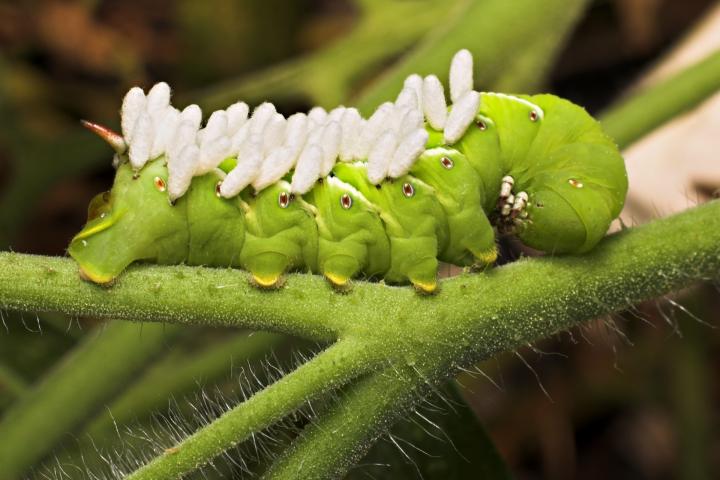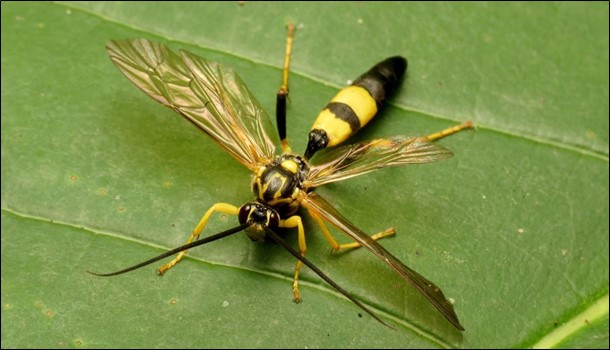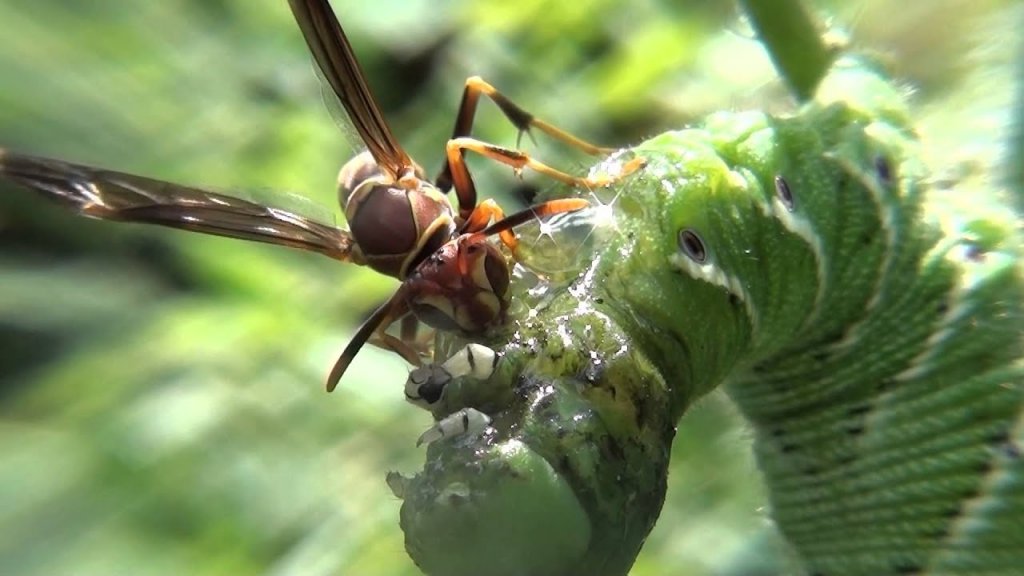Gardening is a delightful endeavor, offering the joy of growing your favorite vegetables.
Vigilance is key in protecting your garden from pests and insects that threaten plantations.
A common adversary for gardeners is the tomato hornworm.
These pests can wreak havoc on your crops, particularly tomatoes, potatoes, and eggplants.
Understanding the threat posed by the tomato hornworm, especially when carrying wasp eggs, is crucial for effective garden management.
What exactly are tomato hornworms, and how do they pose such a significant threat to your garden?
These caterpillars are notorious for their ability to defoliate plants, leaving devastation in their wake.
But there’s good news: understanding their behavior, especially when infected with parasitic wasp eggs, can be the key to safeguarding your garden.
In this guide, we’ll delve into the nature of the tomato hornworm, its origin, and its impact on plantations.
We’ll explore effective strategies to combat the damage caused by these pests.
Identifying Tomato Hornworms

Tomato Hornworms (Manduca quinquemaculata) is a prominent threat in gardens, primarily targeting plants in the Solanaceae family, including tomatoes, peppers, eggplants, and potatoes.
Recognizing these pests is the first step in effective management, especially when they are hosts to parasitic wasp eggs, a phenomenon crucial for natural pest control.
Adult tomato hornworms transform into robust-bodied moths, often known as hawk moths or sphinx moths, feeding on nectar.
These pests are prevalent across North America, ranging from northern Mexico to Canada.
It’s important to distinguish them from their close relatives, the tobacco hornworms, which share similarities but have distinct differences.
Tomato hornworms feature unique V-shaped yellow-white markings on their bodies, while tobacco hornworms display white diagonal lines.
Additionally, the tomato hornworm’s horn-like protrusion on its rear is black, contrasting with the tobacco hornworm’s reddish horn.
Understanding these differences is vital, especially when considering the role of parasitic wasps.
These wasps lay eggs on tomato hornworms, leading to a unique biological control method against these pests.
Click on the link below to understand Tomato Hornworms better.
The Life Cycle of Tomato Hornworms
The life cycle of the tomato hornworm is a critical aspect to understand for effective garden management.
In winter, these pests survive as pupae, transforming into adult moths come spring.
The female moths lay oval green eggs on the undersides of leaves, initiating a new cycle of caterpillars that feed voraciously on your plants.
These caterpillars reach full size in three to four weeks and then burrow into the soil to pupate.
The interesting twist in this cycle occurs when parasitic wasps come into play.
These wasps lay their eggs on the tomato hornworm caterpillars.
The presence of wasp eggs is a natural form of pest control, as the hatching wasp larvae consume the hornworm from within, eventually leading to its demise.
This interaction is a crucial element in the life cycle of tomato hornworms with wasp eggs.
In mid-summer, the moths start their second generation. They lay eggs again on host plants like tomatoes and eggplants.
The cycle continues with caterpillars feeding until late summer or early fall, after which they pupate.
Understanding this cycle, especially the intervention of wasp eggs, is key to managing the threat posed by these garden pests.
Refer to the link below to learn in detail about the life cycle of tomato hornworms.
Parasitic Wasps

Parasitic wasps play a crucial role in garden and farm ecosystems, acting as natural protectors against various insect pests.
These wasps spend a part of their lifecycle living as parasites within other insects, making them a unique and vital group in the insect world.
They belong to one of the largest insect groups, with hundreds of species varying in shape, size, and color.
Typically, they range from small to medium size and are usually brown or black, while their larvae are cream-colored.
Click the link below to understand parasitic wasps in detail.
The Crucial Role of Parasitic Wasps
In garden pest control, parasitic wasps are invaluable.
They naturally regulate populations of aphids, scales, whiteflies, sawfly larvae, ants, leaf miners, and various caterpillars, including the tomato hornworm.
When gardeners use insecticides, they often inadvertently harm these beneficial wasps, which can exacerbate pest problems.
The interaction between parasitic wasps and tomato hornworms is particularly fascinating.
The wasps lay their eggs on the hornworms, and the hatching larvae feed on the caterpillar from within.
This natural process is an effective form of biological control, reducing the need for chemical pesticides.
Understanding and promoting the presence of parasitic wasps in your garden can be a game-changer in managing the tomato hornworm with wasp eggs, ensuring a healthier and more balanced garden ecosystem.
Tomato Hornworms & Parasitic Wasps
Tomato hornworms (Manduca quinquemaculata) are a real threat to your tomato gardens.
These caterpillars can quickly damage the entire tomato plant.
So, if in case you identify them in your gardens or plants just pick them up and throw them away that is the only way to get rid of them.
The female parasitic wasp lays her eggs under the skin of the hornworms.
As the eggs under the skin hatch, the larvae begin to serve on the hornworm.
The larvae eat their way out of these caterpillars and spin them.
Eventually, then adult wasps will emerge as cocoons and the hornworm it survived on will die.
Damage Caused by Tomato Hornworms

The damage inflicted by tomato hornworms on gardens is significant.
These caterpillars aggressively defoliate a range of vegetables, including tomatoes, potatoes, eggplants, and peppers.
Their appetite is not limited to cultivated plants; they also feed on various weeds, exacerbating their threat.
As they mature, their capacity for destruction grows.
They begin by attacking the upper leaves, gradually moving to other parts of the plant.
In severe infestations, they can damage the fruits themselves, leading to stunted growth and a loss of market value.
The extent of damage underscores the need for effective control measures.
This is where the role of parasitic wasps, specifically targeting tomato hornworms with wasp eggs, becomes invaluable.
The wasps lay their eggs on the hornworms, and as the larvae hatch, they feed on the caterpillar from within.
This natural predatory relationship is a vital component in controlling the tomato hornworm population, reducing the need for chemical interventions, and preserving the health of your garden.
Ways of Controlling Tomato Hornworms
Addressing the issue of tomato hornworms in your garden requires prompt and effective action.
One straightforward method is physical removal: simply pick and discard the hornworms as you find them.
This approach necessitates regular garden inspection to catch the pests early.
Apart from physical removal, several other strategies can be effective in controlling tomato hornworms.
- Vigilant Monitoring: Regularly inspect your plants, especially for signs of tomato hornworm with wasp eggs. Early detection is key to preventing widespread damage.
- Biological Insecticides: Utilizing Bacillus thuringiensis (Bt), a naturally occurring bacterium, can be an effective organic solution. It specifically targets caterpillars while being safe for other garden inhabitants.
- Insecticidal Soaps: These are effective against hornworms when applied directly. They disrupt the insect’s cell membranes without harming beneficial insects like parasitic wasps.
- Spinosad Pesticides: Another option for controlling hornworms, Spinosad is derived from soil bacteria and is effective when ingested by the caterpillars.
Preventive Measures from Tomato Hornworms
To safeguard your garden against tomato hornworms, proactive measures are essential. Implementing these strategies can greatly diminish the likelihood of infestation:
- Soil Tilling: Before and after each gardening season, till your soil. This practice disrupts the life cycle of overwintering larvae, effectively reducing their population by up to 90%.
- Encouraging Natural Predators: Foster an environment conducive to parasitic wasps, the natural enemies of tomato hornworms. These wasps lay eggs on the hornworms, and their larvae consume the pests from within. This biological control is not only effective but also environmentally friendly.
- Beneficial Insects: Introduce other garden-friendly insects like ladybugs and green lacewings, which predate on hornworms and other pests.
- Interplanting: Implement interplanting strategies in your garden. Growing dill, marigold, or basil alongside your main crops can deter hornworms and provide additional ecological benefits.
- Weed Control: Regularly remove weeds from your garden. This reduces potential egg-laying sites for the hornworms, minimizing the chances of an outbreak.
Refer to the below link to get more detailed information on managing tomato hornworms.
Conclusion
We understand that your garden is very dear to you, and such attacks by tomato hornworms or other insects just upset you.
But do not worry, these attacks can be overcome by some attentive activities and measures that we studied in the above article.
Your garden is your responsibility. Pests and insects are always going to make their homes inside. Some will be useful while some will be harmful.
There is nothing to worry about. It can always be overcome by responsive efforts and measures.
We hope that the measures and guides that we provided in this article help you get rid of your tomato hornworms in the garden. And then finally you could feel relieved.
Hope to see and hear stories of your happy garden without tomato hornworms. Happy gardening.

